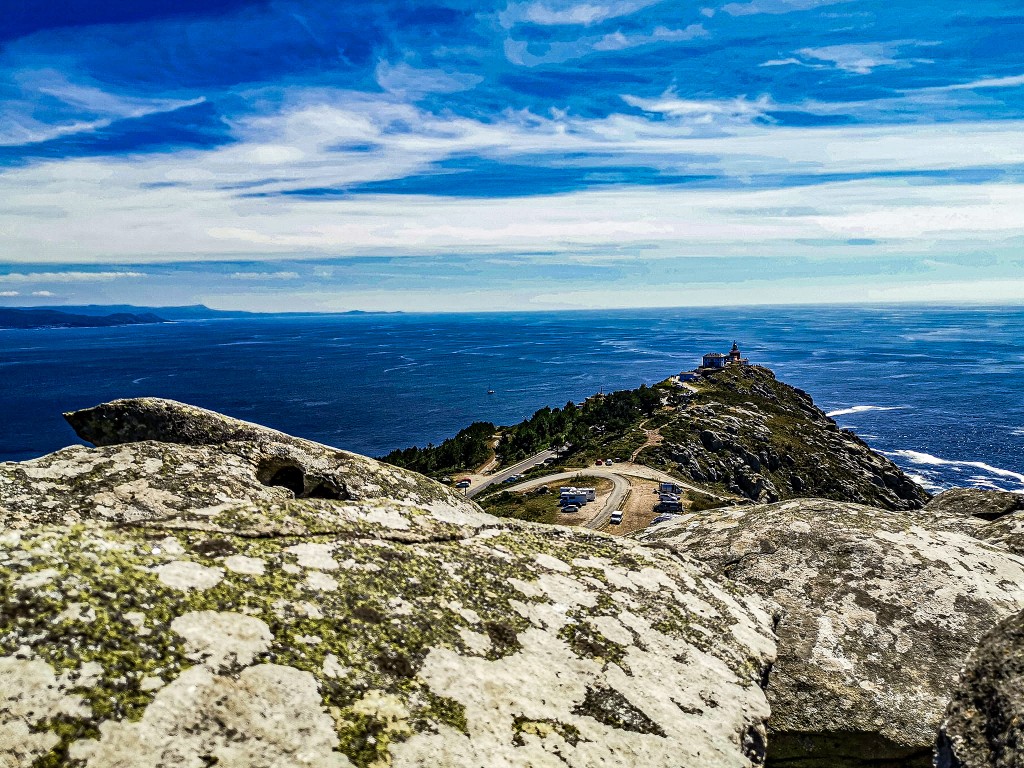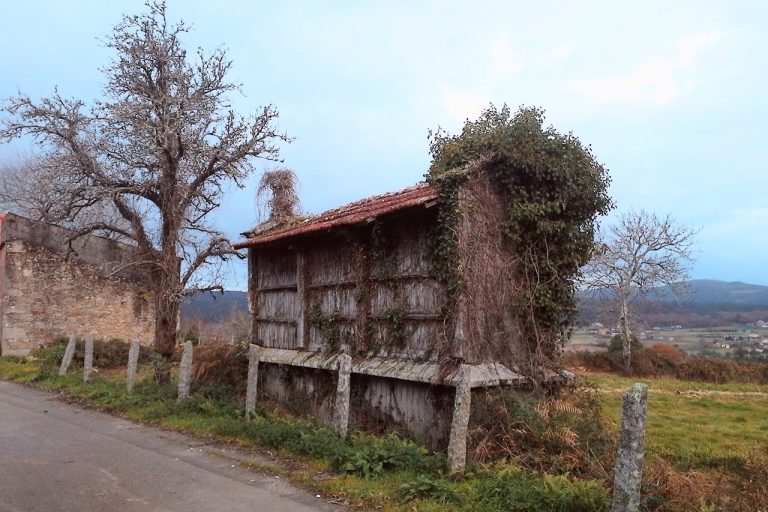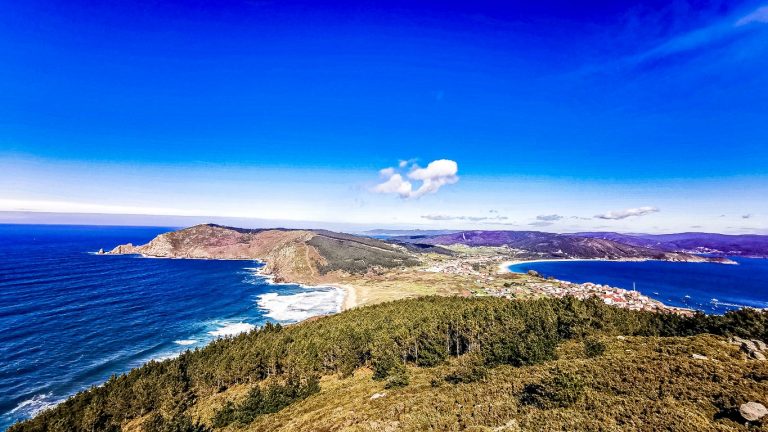
A New Stage Day – Beginning & Mood
Olveiroa wakes slowly. Mist drifts between the old hórreos, thin smoke rises from the chimneys. The air is damp and cool, the village still half asleep. Those who set out early hear the distant murmur of the Río Xallas and the dull tapping of walking sticks on the stone pavement.
Today the road to the sea begins. From here, the paths divide – left toward Muxía, right toward Fisterra. The stone at the crossroads bears both shells, two directions, one destination: the sea. You turn right, walking toward the sunrise.
The Camino opens into a wide, quiet landscape. Morning haze lingers over the fields, and somewhere a rooster crows. It is a silent kind of walking – the heart light, the step steady, the thought unbound.
Route & Elevation Profile
• Distance: approx. 32.8 km
• Elevation: +460 m / –910 m
• Difficulty: moderate
• Duration: 7–8 hours of walking
• Character: gentle hills, forests and open valleys; later a coastal path with views of the sea
This stage leads from the Galician highlands down to the Atlantic coast.
It is long, but not harsh – a day unfolding like a breath: beginning in stillness, ending in vastness.










Description of the Way – With All Senses
You leave Olveiroa at dawn. The path rises gently between stone walls, then crosses a small stream. After about one kilometer you reach the fork: left to Muxía, right to Fisterra. A yellow arrow points the way down toward the sea.
The Camino passes through Hospital, a small hamlet with a bar – the last place before the landscape opens wide. Then comes a soft rhythm of ups and downs through woods and fields until O Logoso (Km 3.5). It’s worth a short pause here. The wind blows cool from the west, and the air smells faintly of salt.
Beyond O Logoso begins the descent into the valley of the Río Hospital, then onward to Dumbría (Km 6). Fields, meadows, eucalyptus. The world feels tidy and quiet. The Camino winds in long loops over the hills, from which the first pale reflections of the sea can already be sensed in the distance.
Then it passes through small villages like Buxantes and San Pedro Mártir, past chapels, farms, and wide meadows. Beyond As Carizas begins the gentle descent toward the coast.
After about 22 km you reach Cee, the first town by the sea. From above, you already see the wide bay. The first seagulls circle, and the wind carries the scent of salt and seaweed. The moment when the sea first appears is quiet – many simply stop and stand still.
Cee is full of life – shops, bars, voices, colors. From here, the Camino follows the shoreline toward Corcubión (Km 26.5), a small fishing village with narrow lanes and whitewashed houses. A rest at the harbor or a coffee overlooking the sea is well worth it.
The final kilometers to Fisterra first follow the road, then narrow coastal paths. The wind strengthens, the spray is in the air. Passing Sardiñeiro and San Roque, the Camino follows the curve of the bay.
Finally, beyond the last bend, Fisterra appears – the end of the world. The town lies on a peninsula, surrounded by water, quiet and luminous in the afternoon light. Those with strength left continue to the lighthouse at Cabo Fisterra, three kilometers further on. There, the land ends.
Towns & Highlights
| Town | Distance from Olveiroa (km) | Highlight | Tip |
| Hospital | 2.5 | Junction Fisterra / Muxía | Landmark, bar |
| O Logoso | 3.5 | Small hamlet with rest spot | Breakfast or coffee |
| Dumbría | 6.0 | Transition into open hill country | Water point |
| Cee | 23.0 | First view of the sea | Rest and resupply |
| Corcubión | 26.5 | Fishing village, historic center | Pause at the harbor |
| Sardiñeiro | 30.5 | Coastal path, view of the cape | Photo stop |
| Fisterra | 32.8 | End of the stage | Lodging and lighthouse visit |
Variants & Small Detours
Between Cee and Corcubión, you can either follow the official seaside path or take a quieter inland variant. Many pilgrims split the stage and stay overnight in Cee, to enjoy the final stretch in the morning.
The climb to the lighthouse at Cabo Fisterra is optional, but almost everyone walks it – a quiet closing of the Camino.
Packing & Shopping Tips
• Between Olveiroa and Cee there are hardly any shops – bring food and supplies.
• In Cee and Corcubión: supermarkets, bakeries, pharmacies, banks.
• Wind and rain protection for the afternoon – coastal weather changes quickly.
• In Fisterra: restaurants, pilgrim hostels, small shops, and laundry facilities.
Food, Lodging & Services
Cee, Corcubión, and Fisterra offer many accommodation options – from albergues to small guesthouses. Those who stay in Cee can enjoy the sight of the sea in the evening and walk the final stretch calmly the next morning.
In Fisterra, the sea is the center of everything. Here the road ends, but the movement remains. Many walk to the lighthouse, sit among the rocks, and fall silent. Some bring a stone they lay down by the water.
Today’s Essence
Today you meet the Atlantic. Not as a destination, but as a mirror – a quiet, moving end to the road. The wind carries salt, the sun breaks through the clouds, and for a moment, everything seems to rest.
The Camino does not end at the cathedral, but here – where the land stops and the sea begins.
Reflection at Day’s End
Perhaps it takes an ending to understand walking. The sea stands still and moves at once – like the Camino within you. Today, you don’t need to seek anything. Just stand. Just see, and breathe deeply.
📊 Stage Overview
| Stage | Start | Destination | Distance (km) | Elevation (+/–) | Difficulty | Key Stops |
| 3a | Olveiroa | Fisterra | 32.8 | +460 / –910 | moderate | Hospital, O Logoso, Cee, Corcubión, Sardiñeiro |
🌌 Camino of the Stars
Olveiroa → Hospital → O Logoso → Dumbría → Cee → Corcubión → Sardiñeiro → Fisterra
When did you first see the sea? Write that moment down – not what you saw, but what you felt.


